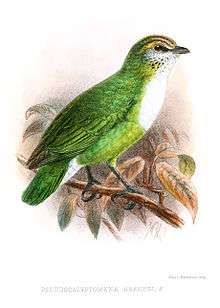Grauer's broadbill
Grauer's broadbill (Pseudocalyptomena graueri), also known as the African green broadbill, is a species of bird in the family Eurylaimidae, and is monotypic within the genus Pseudocalyptomena.[3] Its name commemorates the German zoologist Rudolf Grauer who collected natural history specimens in the Belgian Congo.[4]
| Grauer's broadbill | |
|---|---|
 | |
| Scientific classification | |
| Kingdom: | Animalia |
| Phylum: | Chordata |
| Class: | Aves |
| Order: | Passeriformes |
| Family: | Eurylaimidae |
| Genus: | Pseudocalyptomena Rothschild, 1909 |
| Species: | P. graueri |
| Binomial name | |
| Pseudocalyptomena graueri Rothschild, 1909[2] | |
Taxonomy
Baron Walter Rothschild, who described this species, considered it to be a flycatcher only superficially similar to the Asian broadbills of the genus Calyptomena, hence the name pseudo- or "false" Calyptomena.[2] It is currently regarded as an actual broadbill, one of only a few African representatives of a primarily Asian family.
Description
It is bright green with a blue throat and vent and a small bill, quite unlike those of other broadbills. Adults have finely black-streaked buff crowns and narrow black eyestripes.[2]
Habitat and range
It occurs in tropical moist montane forest, and is endemic to the Albertine Rift Mountains of the Democratic Republic of Congo and Uganda. In Uganda it is a rare resident at 2,100 to 2,200 metres in the Bwindi Impenetrable Forest.[5] Density is probably less than one individual per km2.[1]
Diet
Grauer's broadbill feeds on seeds and fruit, flowers and flower buds, and some invertebrates.[1]
Status
This species is rare, but currently protected only in part of its range. It is threatened by deforestation and habitat degradation, particularly as its currently known distribution overlaps with areas that have seen massive human population influxes in the recent past. It has been classified as vulnerable by the IUCN.[1]
References
- BirdLife International (2012). "Pseudocalyptomena graueri". IUCN Red List of Threatened Species. 2012. Retrieved 26 November 2013.CS1 maint: ref=harv (link)
- Rothschild, H. (1909). "Description of a new bird from Africa". Ibis. 51 (4): 690–691. doi:10.1111/j.1474-919x.1909.tb05277.x.
- Thomas M. Brooks; John D. Pilgrim; Ana S. L. Rodrigues & Gustavo A. B. Da Fonseca (2005). "Conservation status and geographic distribution of avian evolutionary history". In Andy Purvis; John L. Gittleman & Thomas Brooks (eds.). Phylogeny and Conservation. Conservation Biology. 8. Cambridge University Press. pp. 267–294. ISBN 978-0-521-82502-3.
- Beolens, Bo; Watkins, Michael (2003). Whose Bird? Men and Women Commemorated in the Common Names of Birds. London: Christopher Helm. p. 94.
- Britton, P. L., ed. (1980). Birds of East Africa: their habitat, status and distribution. Nairobi: East Africa Natural History Society. pp. 112.
Further reading
- Kingdon, Jonathan (1989). Island Africa: The Evolution of Africa's Rare Plants and Animals. Princeton, New Jersey: Princeton University Press. pp. 184. ISBN 0-691-08560-9.
- Lambert, Frank; Woodcock, Martin (1996). Pittas, Broadbills, and Asities. Sussex, England: Pica Press.
External links
- BirdLife Species Factsheet.
- Pseudocalyptomena graueri - Animal Diversity Web
